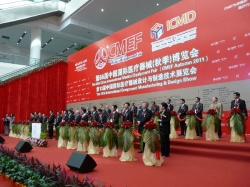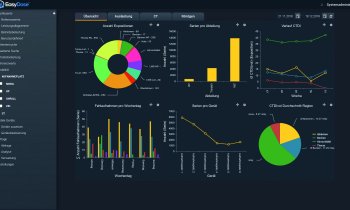Key Trends in IVD, Medical Imaging, and Healthcare IT in/from China
CMEF in Fuzhou Showcases Technology Updates, Provides Platform for Know-how Exchange
Improving access to care in particular for the rural population - this was one of the major goals of the Five-Year Plan which recently ended; and it has made its way again to the top of the agenda in the People's Republic. Two factors are on policymakers' minds: social stability, and the increase in domestic demand which the Chinese economy needs to reduce its dependency on exports.


Basic health insurance is supposed to make disadvantaged groups spend their money instead of saving it up to pay for any medical treatment they might require. Subsidizing the supply of IVD and imaging diagnostics devices as well as IT-based communication tools, in particular to the needy rural care providers, are cornerstones of the campaign for modernization.
In this context, a broad spectrum of devices and solutions originating in China and abroad was showcased early November at the 66th semi-annual CMEF (Chinese International Medical Equipment Fair, http://en.cmef.com.cn). Around 120,000 visitors came to visit 5,600 booths in Fuzhou / Fujian Province, Southeastern China.
Trends: in-vitro diagnostics
IVD is a hot market in China, described Nat Whitney: in top-category hospitals, international vendors witnessed an annual increase in sales of up to 50 percent; in the lower categories, mostly domestic manufacturers profit from the enormous surge in demand and investment, the market researcher went on to explain. He currently counts a minimum of 332 Chinese manufacturers, with quite many looking at exporting. These manufacturers will need to build quality control features into their products for the European and US markets.
Cost-effectiveness is certainly a must for vendors aiming at selling to countries like China, explained Andreas Knaack from Invetech. The focus, however, is not just on low cost but also on ease of use, rapid turnaround, and reliability. "Designing down" with regard to the number of features may be a likely option for vendors going to China.
Trends: medical devices
Double-digit growth dominates also this sector, summed up Glenn Hou. In Fuzhou, the Executive Director, Frost & Sullivan China, presented a study on the market penetration in the country. Results include - besides the obvious saturation regarding imaging in top-tier hospitals: for tier-two, penetration is low for MR, moderate for CT, and high for X-ray and ultrasound. And in tier-one, even ultrasound devices are lacking. - Among product launches at CMEF, Mindray showed plug-in patient monitoring modules and ultrasound to be carried by hand.
Trends: IT
Major vendors whose portfolios include HIS and PACS solutions came to the show, such as Anke, Neusoft, and Huahai. From Europe, hcc GmbH was among exhibitors at the German Pavilion, presenting its open-source based HIS myCare2x. The solution from this SME integrates all types of information and services in these organizations into one single efficient information system; for CMEF, it sported a brand new user interface in Chinese. "Hospitals here are asking for EMR systems to channel patient data and provide better care", said Joachim Mollin in Fuzhou. "The collection of all treatment data helps the patient especially when he/she is sent to another institution for further treatment." Support from local partners plays a crucial role, added the CEO, hcc GmbH. "Our idea for supporting and developing an open framework and main functionality with our team from Germany, and to enable locals partners - through a continuing transfer of know-how - to adapt to local requirements, will be key factors for success in this huge market."
Trends: transformation of care
Concurrently with CMEF, high-level conferences served to attracted attendees, e.g. the China International Summit for Strategic Studies in Imaging (CSSI 2011) & 2011 Multi-Modality Molecular Imaging Symposium (CIMIS). Important policy adaptations, macro-economic trends, and major trends in medical imaging as well as networked communication addressed policymakers and representatives from hospital management, imaging experts, and leading vendors. Among the presenters, Prof. Dai Jin Ping, radiologist and Vice President of the China Medical Association, described the emerging reality of teleradiology services.
Coming from a three-tier system, care in China will be transformed into two tiers, predicted Hou: tier-three and selected specialized tier-two hospitals will perform top-level medicine for cancer and CVD; other tier-two, and the tier-one hospitals will provide primary care and therapy for chronic diseases. Telemedicine will provide access to care where physicians are lacking. – The next CMEF will again deliver detailed insights into the market and its players – Shenzhen, 17-20 April 2012.
05.12.2011











